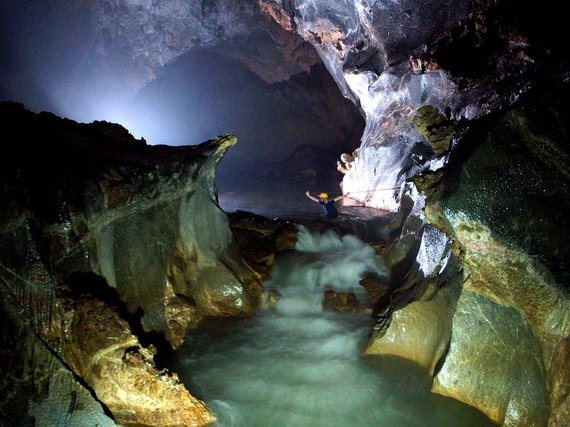by Ken Jennings, Condé Nast Traveler
It's often said that the Age of Exploration is over. Mount Everest has been scaled, Antarctica traversed, every inch of every vast desert or rainforest mapped with satellite imagery and laser ranging technology. Modern-day explorers must look to other frontiers not yet mapped in any atlas: the bottom of the sea, for example, or faraway Mars. But sometimes we forget another unmapped mystery, often nearer at hand: subterranean caves.
The world's largest cave is on the border of Vietnam and Laos.
Half a million tourists visit Mammoth Cave in Kentucky every year. Mammoth Cave is the world's longest cave system, with over 405 miles of passageways known and more being discovered every year. But it doesn't contain the world's single biggest cave. For that, you'd have to trek through the dense jungle of Vietnam's Phong Nha-Ke Bang National Park, home of Son Doong Cave.
The cave was only discovered recently -- and then lost again for two decades.
In 1990, a local farmer named Ho Khanh was hiking through the national park, gathering firewood and aloe. He stumbled on a remarkable site: an enormous cave entrance in a limestone cliff, with clouds and wind billowing out of it. A rushing river poured from its entrance. Khanh remembers that it "felt like something from the underworld," and he returned home without exploring it. He soon forgot its location. It wasn't until almost twenty years later, during a chance conversation with some British spelunkers exploring the area, that Khanh began looking again for the cave entrance. In 2008, he ran across the cave again, and led an international team there the following year.
Measuring Son Doong Cave took years.
The first expedition into Son Doong ("Mountain River") Cave was stopped by a 200-meter barrier that the spelunkers dubbed the "Great Wall of Vietnam." It wasn't until the following year that a team traversed the rock wall, and were able to reach the end of the cave's largest chamber, determining it to be the largest in the world.
The world's largest cave has its own weather.
How big is Son Doong Cave? It's five miles long, 650 feet high and 500 feet wide. It could hold an entire city block of Manhattan, including 40-story skyscrapers. It has its own lush vegetation where sunlight filters in from sinkholes above, and clouds even form near the ceiling when moisture condenses there. The world's tallest stalagmites tower 260 feet in the air, and limestone "cave pearls" the size of baseballs litter the cave floor. This amazing underground cathedral is a potent reminder that there are still remarkable landscapes on Earth waiting to be discovered.
More from Condé Nast Traveler:
THESE Are The Best New Hotels in the World
